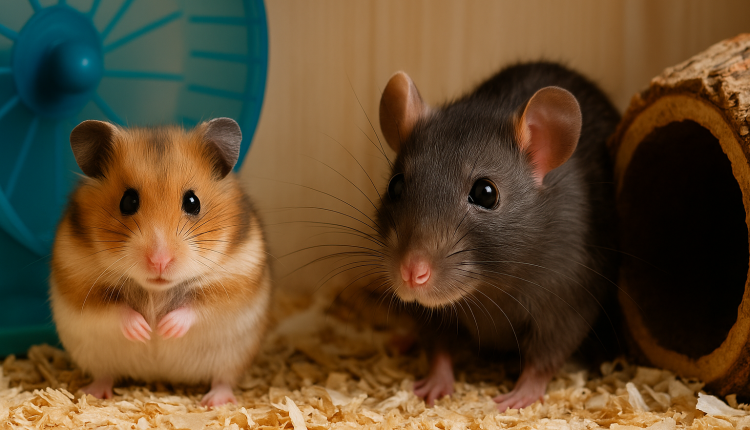Creating the Ideal Environment for Your Pet Hamster or Rat: Enrichment, Comfort, and Mental Health
Small pets like hamsters and rats are often underestimated in terms of their intelligence, emotional needs, and capacity for enrichment. While they may not bark or purr, these animals are highly perceptive, sensitive to stress, and thrive in environments that challenge and engage them.
Many pet owners provide the basics — a cage, food, water — but few understand the importance of crafting a truly stimulating and emotionally safe environment. This article will explore how to design a habitat that supports not only physical health but also mental well-being, with a focus on enrichment techniques and habitat setup for both hamsters and rats.
Understanding Natural Behaviors: The Foundation of Good Habitat Design
To build an optimal environment, it’s essential to understand how hamsters and rats behave in the wild:
- Hamsters are solitary, burrowing animals that roam vast areas at night searching for food. They are territorial and require space to dig, run, and explore.
- Rats, in contrast, are social and intelligent. They build complex nests, groom one another, and problem-solve with enthusiasm. They enjoy companionship and require mental challenges to stay healthy.
Designing a habitat that mimics these instincts can dramatically improve your pet’s quality of life.
Cage Size and Structure: More Than Just a Box
For Hamsters:
- Minimum floor space should be at least 450 square inches (larger is always better). Avoid vertical cages — hamsters need horizontal room to roam.
- Solid flooring is a must. Wire floors can injure small feet.
- Deep bedding (6 inches or more) allows natural burrowing behavior.
For Rats:
- Multi-level cages are ideal. Rats love to climb and explore.
- Bar spacing should be 0.5 inches or less to prevent escape.
- Minimum size for two rats is 24″ x 24″ x 36″, but more space is better.
Both species benefit from enclosed spaces, hideouts, and tunnels that offer a sense of security.
Bedding and Substrate: Comfort and Safety
- Avoid pine and cedar shavings, which release harmful aromatic oils.
- Opt for aspen, paper-based bedding, or hemp.
- Ensure bedding is dust-free, absorbent, and changed regularly.
Hamsters will naturally hoard food and nest in bedding. Rats often use one area of their enclosure for elimination and another for sleeping — this makes litter training possible.
Enrichment: Stimulating the Mind
Enrichment is essential to prevent boredom and stress. This includes toys, activities, and changes to their environment.
Ideas for Hamsters:
- Running wheels with a solid surface (minimum 8″ diameter for dwarfs, 10–12″ for Syrians).
- Dig boxes filled with sand or coconut fiber.
- Cardboard mazes, tunnels, and platforms.
- Food puzzles or scatter feeding to simulate foraging.
Ideas for Rats:
- Hammocks, ropes, and climbing ladders.
- Shredded paper or tissue for nest-building.
- Interactive toys like treat-dispensing balls or puzzle feeders.
- Rotation of items — changing toys weekly keeps things novel.
Rats, in particular, enjoy supervised time outside the cage in a safe, enclosed area known as “free roam.” This is critical for mental stimulation.
Social Needs: Solitary vs. Social Living
- Hamsters (especially Syrians) must be housed alone. Even dwarf breeds that tolerate cohabitation can fight unexpectedly, so caution is advised.
- Rats are extremely social and must be kept in pairs or groups. A lone rat often shows signs of depression, including lethargy, overgrooming, and decreased appetite.
Social enrichment for rats includes mutual grooming, play, and cuddling — they often nap together and rely on their companions for security.
Nutrition as Enrichment
Feeding isn’t just about sustenance; it can be mentally enriching, too.
- Offer a varied diet of lab blocks or pellets plus fresh vegetables, occasional fruits, seeds, and safe herbs.
- Foraging opportunities like hiding treats or scattering food throughout the cage encourage natural behaviors.
- Avoid sugary or fatty treats — moderation is key, especially with hamsters, who are prone to diabetes (particularly dwarf varieties).
Signs of a Happy, Enriched Pet
How do you know your pet is thriving?
Happy Hamster Behaviors:
- Burrowing and rearranging bedding
- Running actively at night
- Hoarding food and nesting in hideouts
- Exploring toys and tunnels
Content Rat Behaviors:
- Grooming companions or you
- Playful wrestling
- Interacting with toys
- Approaching cage doors for attention
Behavioral problems like bar-biting, excessive hiding, or lethargy often indicate stress or boredom.
Cleaning and Maintenance: Keeping It Healthy
A clean environment is essential — but over-cleaning can also stress your pet.
- Hamsters rely on scent markers to navigate their space. Spot-clean regularly and deep-clean monthly, preserving some clean, used bedding to maintain familiar smells.
- Rats require more frequent spot-cleaning due to their higher waste output. Clean hammocks and cloth items weekly.
Always use pet-safe cleaning products and rinse thoroughly.
Safe Handling and Bonding
Gentle, respectful interaction builds trust.
- Let hamsters wake up on their own and approach you in their time.
- Rats respond well to training and can even learn tricks or come when called.
- Avoid forcing interaction. Use treats and consistency to build positive associations.
Never grab your pet suddenly or from above, as this mimics a predator attack and can break trust.
Final Thoughts
Creating a habitat that supports the full spectrum of your pet’s needs is an act of respect and care. Hamsters and rats may be small, but their inner worlds are rich and deserving of thoughtful, enriched environments.
By aligning their living space with their instincts — giving them space to burrow, climb, forage, or cuddle — you not only prevent behavioral issues but also open the door to a deeper connection with your pet.
These intelligent, sensitive animals thrive when their environment encourages exploration, comfort, and expression. Whether you’re a new owner or a seasoned enthusiast, investing in enrichment and well-being is the best way to ensure your hamster or rat leads a happy, healthy life.

